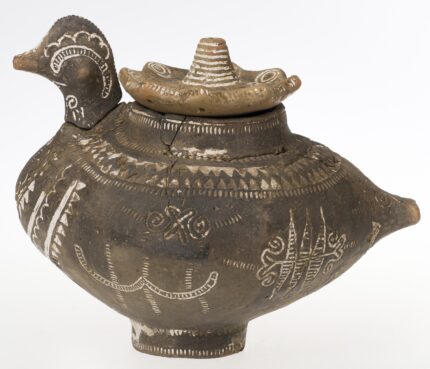A pottery vessel shaped like a duck or another water bird has been discovered in a Bronze Age grave near the town of Baley, northwestern Bulgaria. The vessel is an exceptional example of the highly decorated ceramics produced by the Encrusted Pottery culture, a Bronze Age people that settled the Lower Danube. Their graves are replete with the highly decorated and varied pottery after which the culture is named.
The Baley settlement was inhabited for about 400 years in the 2nd millennium B.C. Its necropolis was discovered by accident 40 years ago and archaeologists have been excavating it ever since. Baley is the only Bronze Age site in Bulgaria where the necropolis can be conclusively linked to a nearby settlement.
The 2020 dig unearthed 15 new graves richly furnished with the characteristic ceramics of the Encrusted Pottery culture, bringing the number of graves discovered at the necropolis up to 132 and making it the largest known Bronze Age necropolis in the Lower Danube region. Of the 15 newly-excavated graves, two date to the first half of the 2nd millennium B.C., 13 to the second half. Eight of them were intact with grave goods and cinerary remains.
“The Baley Bronze Age necropolis is offering [us new] information about the burials rites of the [earliest Ancient] Thracians and their beliefs and aesthetic sense. [The archaeological team] has found very richly decorated vessels. They were used simultaneously as burial gifts and urns in family tombs. The remains of adults and children were placed next to one another,” says [archaeologist Kamen] Boyadzhiev who was not part of the 2020 Baley field research team.
“A finely crafted vessel in the shape of a bird with rich encrusted decoration has made a very strong impression [from among the newest Baley necropolis finds],” he emphasizes. […]
The archaeological team explains that the remarkable bird-shaped encrusted ceramic vessel, which seems like a duck, has been found inside an urn.
“The other [impressive burial] structure consists of three urn vessel preserving the remains of the dead [which were] covered with lid bowls. Among the urns the ancient people had placed three vessels with tall handles and another bowl. In one of the urns, [we] discovered a vessel in the shape of a bird and a bone needle, and in another one – two bronze hair pendants,” the researchers elaborate.

What a cute birdie!!! :chicken:
“The Eurasian coot (Fulica atra) is much less secretive than most of the rail family, and can be seen swimming on open water or walking across waterside grasslands. It is an aggressive species, and strongly territorial during the breeding season, and both parents are involved in territorial defense. During the non-breeding season they may form large flocks, possibly related to predator avoidance. It is reluctant to fly and when taking off runs across the water surface with much splashing. It does the same, but without actually flying, when traveling a short distance at speed in territorial disputes or on land to escape from intruders. As with many rails, its weak flight does not inspire confidence, but on migration, usually at night, it can cover surprisingly large distances. It bobs its head as it swims, and makes short dives from a little jump. When fighting other waterbirds (especially other coots), the coot attacks by charging its opponent and striking them with its legs.”
:chicken:
upload.wikimedia.org/wikipedia/commons/8/89/Fulica_atra_on_ice.jpg 🐦️
The Karate Coot!